

Mankind has survived all kinds of pandemics, even the plague. However, humans are ill-equipped when confronted with an invisible danger. Moreover, the COVID-19 pandemic has four important features which almost certainly overstretch the human analytical capacity: Time-lags, external effects, nonlinearities and complexity. We cannot escape our biases when deliberating COVID-19. But being aware of them might yield more cautious and less apodictic views. Our evolutionary success can be traced to the fact that we became “social animals” with these biases often enhancing a smooth cooperation. Now it is on the society and its institutions to make sure that they do not cause people turning against society.
Mankind has survived all kinds of pandemics, even the plague. However, humans are ill-equipped when confronted with an invisible danger. Moreover, the COVID-19 pandemic has four important features which almost certainly stretch the human analytical capacity: Time-lags, external effects, nonlinearities and complexity. Given the complexity of COVID-19-related issues, the rational, slow and resource- intensive System 2 thinking (D. Kahneman) quickly surrenders and people switch to intuitive and seemingly effortless System 1 thinking. Often people tend to develop a view which is consistent with their self-image. If a person perceives himself or herself as a self-determined individual, he or she is likely to be more inclined to belittle the threat of COVID-19. For example, by comparing it to a regular flu. Non-experts often pick oversimplified and out-of-context arguments that suit their priors (motivated reasoning). It also seduces them into the usually false conclusion that their own judgment is at par with experts’ views.
Conspiracy theories are an extreme form of motivated reasoning. Any fact which could seriously undermine their beliefs will be trumped by the conspiracy theorists’ “proprietary knowledge” of ’the real reasons’, or by Svengalis unknown to the general public.
System 1 thinking with all its biases makes the government communication policy difficult. Rational, fact-based arguments provided by the government – while not convincing the extreme corona sceptic – are expected by the majority of people. But if statements are perceived as either too shocking or too calming, they often trigger counterproductive behaviour.
Mainstream media should actively work against any bias alleged by corona deniers. Sceptics should get air time, but not merely with the intention to discredit their views or protests.
We cannot escape our biases when deliberating on COVID-19. But being aware of them might yield more cautious and less apodictic views. Our evolutionary success can be traced to the fact that we became “social animals” with these biases often enhancing a smooth cooperation. Now it is for society, and its institutions, to make sure that they do not cause people to turn against society.
The recent news flow regarding the availability of vaccines offers the first realistic perspective that, after a year of struggle with the COVID-19 pandemic, the virus might be brought under control in the near future. However, vaccination concerns, especially about mandatory vaccinations, have always been one of the cornerstones of corona-related conspiracy theories and a key concern among so- called “corona protesters”. In our proprietary survey, we found that between 1/3 and 2/3 of the respondents in the various countries intend to be vaccinated. But governments should prepare for a fierce public debate, where questionable facts and conspiracy theories will fly high. Ironically, the increasing hope that life might soon become more normal might even egg on those people who are convinced the COVID-19 crisis is largely an artefact created by government propaganda and that, in their opinion, a misguided government response could push Germany into a near ’apocalyptic state’. As such, it may lead them to double down on their dissent, as they believe the fears that triggered their resistance and brought them into the streets were ultimately unfounded. Not only these “COVID deniers” – for lack of a better expression, given that probably only a minority deny the existence of the virus altogether, but also “COVID sceptics”, question the political reaction, while the rest, trying to formulate their views, are struggling with the COVID-19 situation. Hence, it might be useful to analyze some of the insights that psychology and behavioral economics can provide to understand how people deal with such extreme stress as brought upon them by the pandemic shock.
Mankind has so far survived all kinds of pandemics, even the plague, which decimated Europe’s population by about 25m or by one third in the 14th century. This achievement probably tells us more about the adaptability of our immune system (one of the key arguments of the COVID protesters, when belittling the threat posed by the coronavirus) than about our cognitive capabilities to deal with such situations.
Why is it so hard to get a grip?
Humans are ill-equipped when confronted with an invisible danger. Human evolutionary success has been the result of coping with threats we could detect with our five senses. The amygdala, the brains fear center, relies heavily on sensory cues – mainly visual and acoustic – which are absent given the (electron-) microscopic size of the coronavirus and the fact that despite the renewed increase in infections, still only a small number of people have directly witnessed someone going through a serious COVID-19 infection. Such cues activate emotional bookmarks, which trigger the body’s response, with the neocortex, the center for a rational and analytical response, being largely sidelined. With respect to the risk posed by the invisible coronavirus, an individual is forced to rely on statistical measures such as R0 or the 7-day incidence per 100,000 population, which are far too abstract to serve as a guidance for individual behavior. Certainly, no ordinary citizen can say how much a rise of the 7-day incidence from 50 to 100 per 100,000 increases their personal risk of catching COVID-19. These statistics are quite often either accidentally or intentionally misinterpreted. An Austrian TV station even argued that the 100,000 basis would “artificially create corona deaths”, when applied to regions with less than 100k inhabitants, thereby inflating the number of corona deaths.2
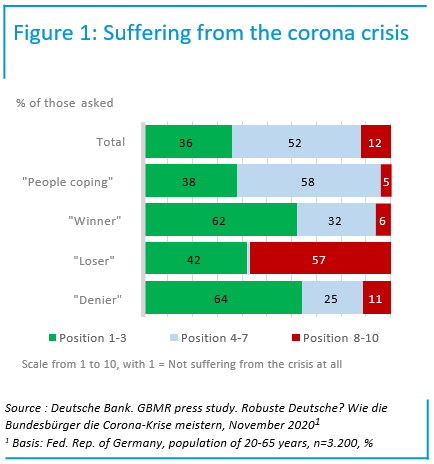 |
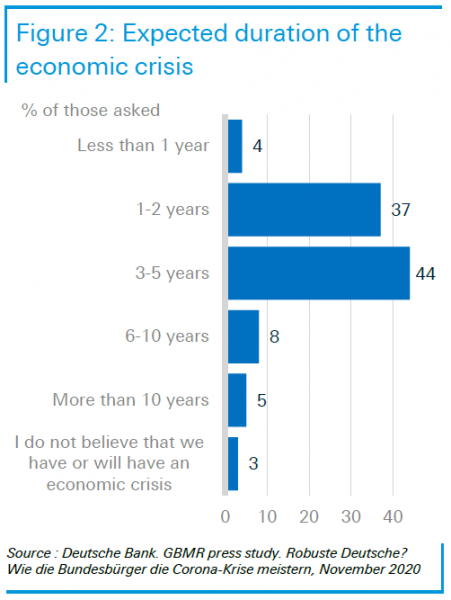 |
In order to assess the individual and collective risks a large number of additional parameters (pattern of social interaction, share of severe cases, health sector capacities, etc.) have to be taken into account, in addition to the absolute or relative number of new infections. Not surprisingly, when people try to assess the risk of COVID-19, they unintentionally take all sorts of shortcuts, rather than trying to interpret and aggregate a large set of heterogeneous, interdependent statistics. The only partly understood parameters driving the pandemic, such as infection probabilities in certain settings or the exact impact of containment measures, make such a comprehensive assessment of the situation very difficult and can probably explain why experts and politicians often seem to differ in their recommendations and preferred measures. Politicians have the additional challenge of balancing measures which are necessary from an epidemiological perspective, with their economic and social impact, and the perception among the population. The difficulties of the task are not only due to Sars-COV-2 being invisible. The COVID-19 pandemic has four other important features, which almost certainly stretch the human analytical capacity. These are: 1. time-lags; 2. external effects; 3. nonlinearities; and 4. complexity.
Given these four, intertwined factors, it comes as no surprise that people have a hard time to deal with the COVID-19 pandemic in a rational way. According to a concept introduced by Daniel Kahneman, our brain has two modes of thinking, which he calls System 1 and System 2.6 With System 2 a controlled, (statistically- based) reasoning approach, while System 1 operates more or less automatically using analogies and associative memories, similar to the commonly used term “gut feeling”. Under the hood, both are actually interacting and influencing each other in various way, without us really being aware of it. Given the complexity of COVID- 19-related issues, the rational, slow and resource-intensive System 2 thinking quickly surrenders and people switch to intuitive and seemingly effortless System 1 thinking, when approaching problems related to COVID-19. That is where things get messy as various biases with respect to the collection and the processing of information kick in, not only leading to suboptimal individual behavior, but also making the management of the crisis such a challenging task.
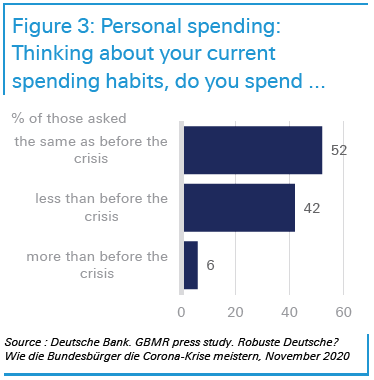
The difficulties of a rational, scientific approach
People are unlikely to evaluate the threat the coronavirus poses to them through an open-ended approach, involving the collection and analysis of relevant data, reading the key papers from pandemic and medical experts – Google Scholar lists 81,000 scientific articles when searching for COVID-19 and SARS-CoV2. This exercise would be extremely time-consuming and it would likely not yield a clear answer. How could it? The vast majority of us are unqualified to interpret such information, and how could we possibly draw conclusions when even experts change their views and estimates on factors, such as the mortality rate, over time. On the other hand, the essence of science is to discover new things, admittedly a truism when dealing with a new phenomenon. Expecting that in that process early results are carved in stone equates to a naive understanding of the scientific process. It should actually be trust-instilling when experts adjust and alter their views in the face of new evidence. Unfortunately, in the case of COVID-19, the scientific debate, in part, takes place in front of the general public. The media, in fighting for attention, sometimes over-simplifies, or exaggerates minor disputes, staging them as showdowns between the luminaries involved. In Germany, the debate about COVID-19 is presented by some media as an almost personal fight between Professor Drosten (Berlin) and Professor Streeck (Bonn), with ntv describing Streeck as the virologist of the second wave while Drosten was the one of the first wave7 – in interviews both strongly reject such staged presentations.
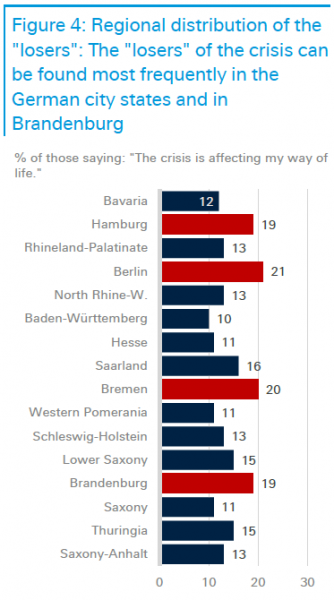 |
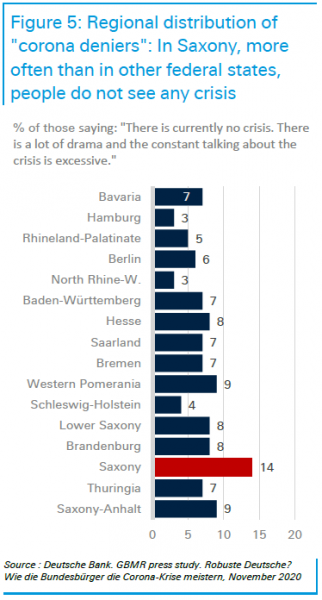 |
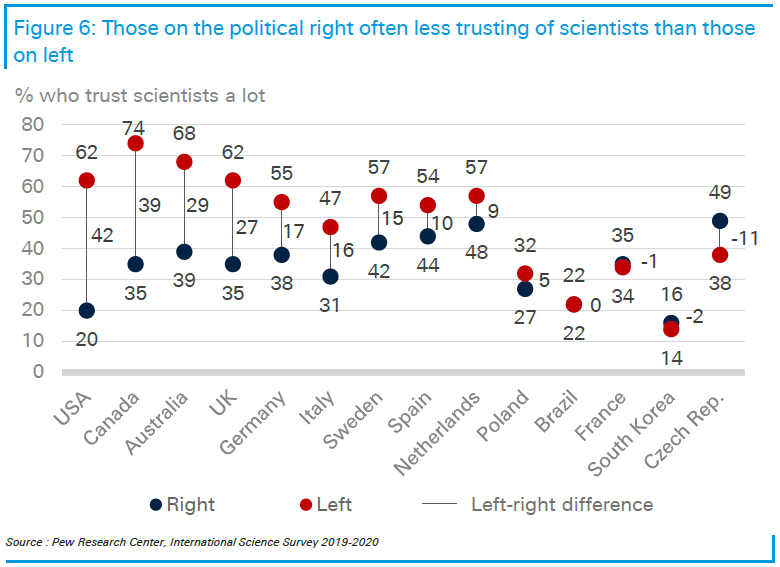
Still, nonprofessional observers often pick whatever oversimplified and out-of- context argument they can distill out of such formats, as long as it suits their priors. It also seduces them into the false conclusion that their own beliefs and deliberations are at par with experts’ views. They fall prey to overestimating their own knowledge, as in reality their limited assessment does not come from their own knowledge but is borrowed from communities of knowledge they are tuned into. The ability to assess the quality of your own knowledge, called “meta-knowledge”, is crucial for information evaluation and decision-making. Experiments show that people overestimate their knowledge even with regard to rather simple subjects.8 Upon testing, there is hardly any correlation between people’s self-assessment and their actual knowledge of a subject. According to sociologists, COVID-19-related conspiracy theories are so appealing to narcissistic individuals, as they provide them with the (false) impression of owning superior knowledge ordinary people (or even experts) do not have.
But even experts rely heavily on their “communities of knowledge”. They have to trust their colleagues and institutions, such as peer reviews, as they cannot reproduce every important new science insight published elsewhere. Trust, however, is an emotion, so even the scientific process cannot escape being influenced by attitudes and beliefs.
Self-image and world view shape the initial assessment by System 1
On the other hand, for almost all really important questions in life there is more than just one (correct) answer and by experience through trial and error we have learned to cope with this uncertainty. Unfortunately, hardly anyone has experience that can be referenced with respect to the COVID-19 pandemic. But rather than starting with a blank sheet, people are quick in subscribing to a hypothesis, which might be shaped by the availability bias, i.e. what assessment was conveyed by the information they consumed most recently, for example, the dramatic pictures from Northern Italy back in March. On the other hand the implicit hope that the pandemic might not turn out so terribly bad after all, can also create a strong motivation for which view will be taken. Often people tend to develop a view which is consistent with their self-image. If a person perceives his or herself as a self-determined, confident and healthy individual, he or she might feel a strong dislike for regulations curtailing freedom and hence be more adaptive to views belittling the threats posed by COVID-19. This probably explains why the flu analogy has been so popular among politicians who see themselves, or want to be seen, as strong leaders. Belonging to a certain social group holding similar views might even reinforce such a stance.9 Research has shown that factors such as gender, race, political world views and affiliation strongly correlate with a person’s risk judgment,10 with white males apparently particularly undisturbed. Moreover, affect is an important factor as well, for both laypeople and experts, especially when assessments and decisions are made under time pressure.
Given the complexity of the question of how dangerous COVID-19 actually is, people are prone to jump to conclusions provided by System 1. One well-known shortcut taken by System 1 is to substitute the difficult original question with a simpler somehow related one, which again might explain the popularity of the flu analogy. Taking self-image consistency and target-question substitution together might explain why voters of the AfD and the FDP assess the health risks posed by the coronavirus much lower than the supporters of other parties. Their conclusion is probably more driven by their dislike of the heavy government responses to COVID-19, such as mobility restrictions and lockdowns. In the case of FDP supporters, that might also be due to their dislike of too much government interference with the economy and its tendency to take the view of the business sector, especially of SMEs and self-employed, which represent their core voter groups. In the case of AfD supporters, the strong dislike of the current government and the political establishment, but also skepticism regarding a science-based policy approach, evident in the party’s stance regarding man-made global warming, might play a bigger role. However, both approaches look at a political response and the economic consequences of the pandemic rather than the coronavirus-related health risks. This phenomenon is not confined to Germany. In a Gallup survey from mid-April, in the United States, 73% of supporters of the Democrats answered that they were very/somewhat concerned about contracting COVID-19 while only 36% of those supporting the Republicans expressed such a worry.11
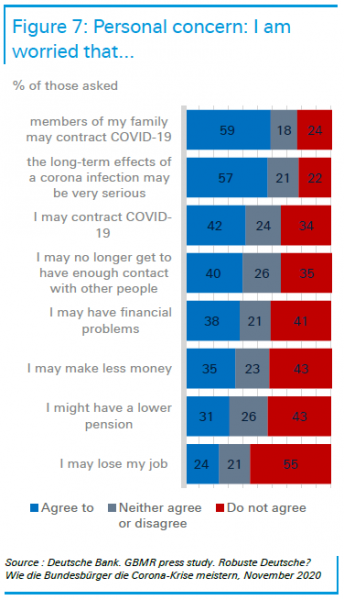 |
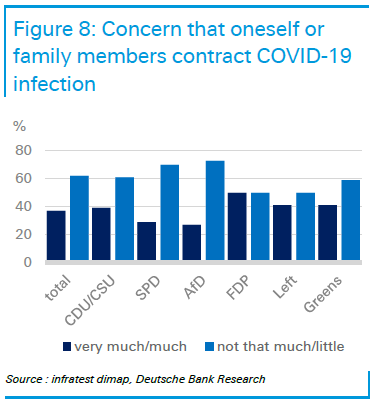 |
People need order and predictability …
If such a biased initial assessment served as the null hypothesis to be rigorously scrutinized afterwards, one could even interpret it as an efficient first step, along the lines of Popper’s falsification theory. Unfortunately, this is not how we humans operate. Once we have made up our mind we want to maintain our seemingly coherent view of the subject and maintain our cognitive ease. This is very important for humans, as it helps us to function in situations of ambiguity and to not get trapped in an endless loop of conflicting assessments. Our brains are extremely good in suppressing ambiguity, which draws massively on the System 2 with its limited resources. We therefore prefer and seek order, which gives us a sense of control or predictability, where we can largely navigate by the means of System 1.
… and they hate to be wrong
The emotional costs of admitting – even just to ourselves – that we got it wrong are quite high. Especially if we strongly believe that the world is largely determined by cause-and-effect relationships, which we then failed to understand. If we accept that many processes and developments in our lives are probabilistic or even completely random, such errors would be easier to swallow, but such a view is itself hard to accept for most of us, as we are trained by evolution to look for cause-effect relationships, “finding” them even where they do not exist.
The first line of defense to protect our initial assessment of a problem is overconfidence. This can relate to the assessment of one’s own health and the ability of avoiding an infection or any complications. It can also relate to the accuracy of one’s own knowledge about the coronavirus. Overconfidence is to a certain degree a positive attitude. It allows us to dare, for example, in establishing a new business, despite the fact that only about half of the start-ups survive the first five years.12 It also fosters the illusion that we have more control over our environment than we actually do.
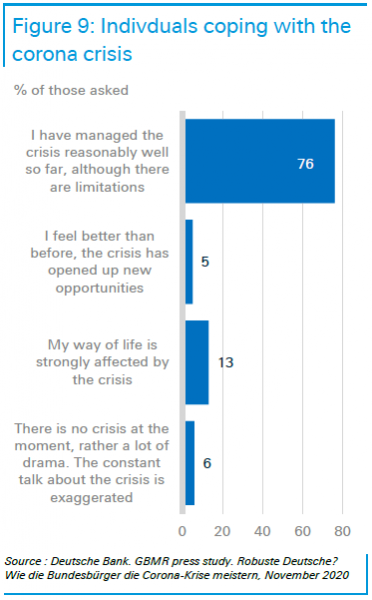 |
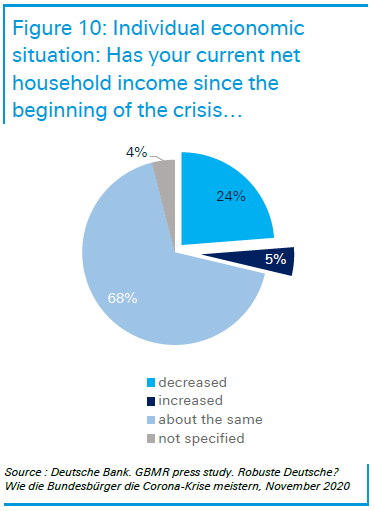 |
Another well-documented defense mechanism is the confirmation bias. People are quite selective with regard to processing new information. While confirmatory evidence is easily accepted and actively sought-for – most of the time without even the most basic checks of the source or reliability, contradictory evidence is ignored or quickly dismissed, often by denouncing it as fake news. If contradictory evidence is mounting, people shield their view by motivated reasoning, citing whatever supportive argument they can find, usually assuming mono-causal relationships in their argumentation, hence falling victim to the isolation effect. For example, in the first few months of the corona debate the Swedish light-handed approach was used as “proof” that the harsh lockdown polices in other countries were unnecessary.13 This argument completely ignored that Sweden is a high-trust, law-abiding society with a population density (24/km2) of 1/10 of Germany’s (240/km2), both factors certainly relevant for the development of a pandemic. Moreover, with the second wave in full swing the Swedish approach looks less successful and exemplary.14
The cumulated number of infections has risen to 2.3% of the population compared to 1.2% in Germany. The death rate provides an even starker contrast, with the Swedish rate (0.07%) higher than Germany’s (0.02%) (Nov. 27th). Even the qoq decline in Swedish GDP in Q2 (-8.3%) was only slightly less steep than in Germany (-9.7%).
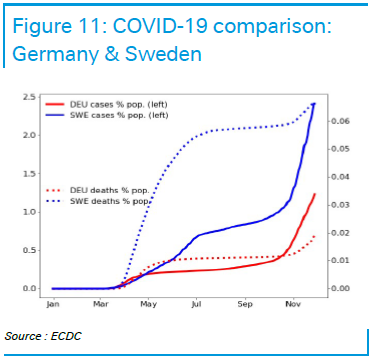
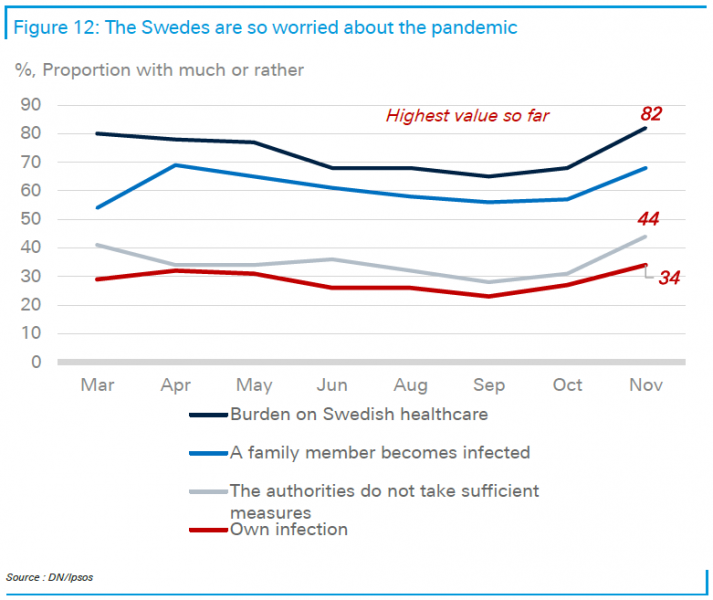
Another common vehicle used in motivated reasoning is counterfactual explanations and arguments, interpreting, for example, the fact that the pandemic in Europe calmed down during summer as evidence that the lockdown measures had not been necessary after all. One could argue that conspiracy theories, so popular among the more fundamental critics of the government’s approach, are an extreme form of motivated reasoning, as well as an extreme reduction of complexity. Any fact which could seriously undermine their beliefs will be trumped by the conspiracy theorists’ “proprietary knowledge” of ’the real reasons’, or by Svengalis unknown to the general public. Conspiracy theories also fit the folk intuition that large events must be the result of proportionally large causes. Obviously the most likely random mutation in the genome sequence of a virus with a diameter of 100nm does not make for a large cause. But research has shown that people have a hard time accepting that their life might by dominated by more or less random events.
Social media’s filter bubbles have massively enhanced these effects as the underlying algorithms are utilizing and thereby catering to the confirmation bias. Targeted, pseudo-scientific input contributes to the overconfidence of the receiver and provides ample ammunition for motivated reasoning, happily ignoring the fact that they are fed with news from their own echo chamber. This also makes them an almost perfect breeding ground for fake news, with the likes, multiple sharing and appreciative commentaries all making them look more true for those with the receptive framing and mindset.
How do people perceive risk?
Although the massive increase in life expectancy provides compelling evidence that modern societies have been amazingly successful in making our life safer, the general public seems to have become more concerned about risks, which might have to do with the increasing median age in most industrial countries. Given the individual biases discussed above, it is hardly surprising that there is quite often a huge chasm between the risk assessment of experts and the perception of risks within the society. While experts usually employ measures of losses (lives financial, etc.) non-scientists have a more intuitive risk assessment which depends on their mindset and culture.15 However, experts’ assessments of risks are hardly objective either, as the initial definition of the problem, especially the way fatalities or losses are measured already implies individual value judgments. With regard to COVID- 19, this is evident in the trade-off between lives saved and the economic damage created by very restrictive measures or the allegation that in some countries corona policies are sacrificing the elderly.16
Research shows that the perception of risks can be summarized across three dimensions, which do have some overlap: 1. Dread risk (lack of control, catastrophic potential, and fatal consequences), 2. Unknown risk (unobservable, unknown, delayed manifestation of harm), 3. number of people exposed to the risk. Obviously, COVID-19 scores high on all three dimensions, but in general the dread risk seems to be the dominant factor for the layperson’s assessment. In addition, the social amplification of risk is an important factor, for example through indirect economic and social costs. A perceived inadequacy of risk management and containment measures works also as a strong amplifier. as evident in the rather low approval rates the national COVID-19 policies are getting in the US and the UK.
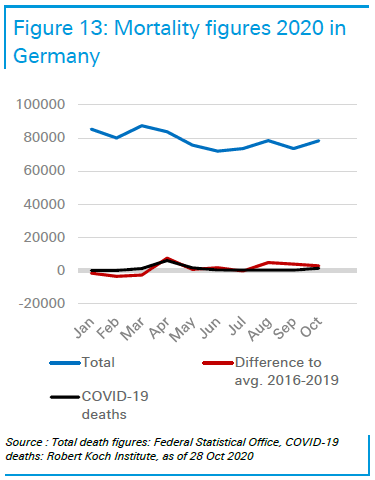
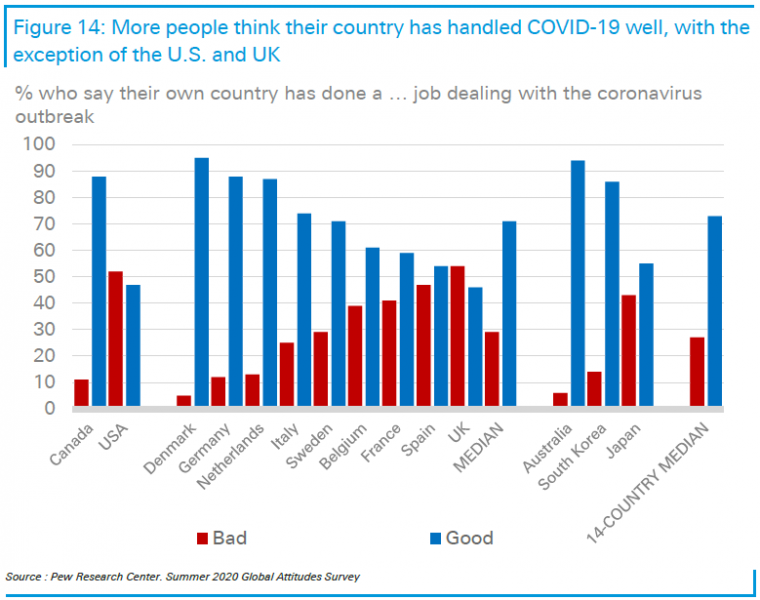
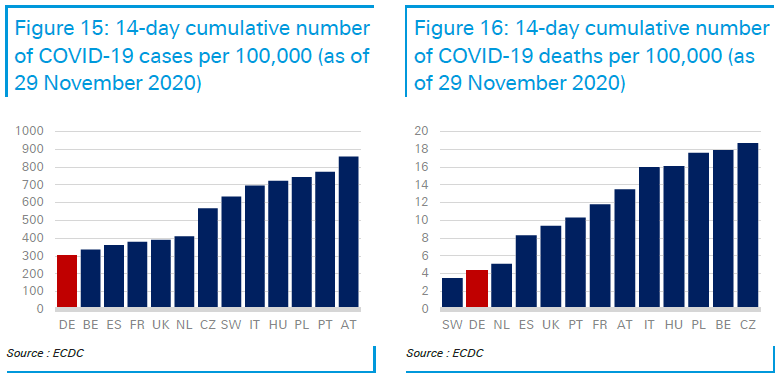
Rare events: Do people worry too much or too little? It depends
The Prospect Theory postulates that subjective decision weights do not decline proportionally with statistical probabilities towards the tails of the distribution, meaning that people overestimate rare events. Explanations are that people pay more attention to salient and unusual outcomes and events (which makes a lot of sense from an evolutionary perspective, as paying attention to rare and unusual things probably increased chances of survival), the confirmation bias which urges people to believe in and look for what they are currently contemplating, or the extent they worry about the impact of the event. This might explain why people clearly responded to shocking TV footage of stacked coffins in Northern Italy. But in the experiments in which this overestimation effect of rare events is evident, people are provided with an ex-ante (usually numerical) description of the probabilities. By contrast, in real life, people usually have to guesstimate these probabilities by experience, i.e. as they go along. This difference is called “description-experience gap”17. In experiments closer to real life, where people are learning the probability distribution over time by repeated choice experiments (experience) – in contrast to the postulation of Prospect Theory – they underestimate rare events. Moreover, in several studies, it turned out that people were satisfied, i.e. stopped repeating the choice exercise, after just a few rounds, meaning that they might not even have experienced a rare event (so-called small sample bias). If a risk is rare, such as in COVID-19 – despite the surging rates, only 1.3% have been infected in Germany – many people experience the “non-occurrence”, triggering less concern than the risk deserves based on probabilities.18 This was demonstrated in previous months when COVID cases were more concentrated in hotspots, by statements like: Among my friends / in our county there are no COVID cases, so what is the big deal?
Teenagers less concerned
Mortality statistics clearly show that adolescents have a higher willingness to accept or even actively seek risk. There is at least some evidence in the literature that teenagers have strong present bias,19 meaning that they give the current fun of going out a relatively higher weight than uncertain future consequences. Experiments show that adolescents have a greater acceptance of ambiguous or uncertain situations. They exhibit a higher willingness to engage in actions with unknown consequences and have only limited interest in looking for uncertainty reducing information.20
If people take these insights provided by research into account, it might help to make the debate somewhat less heated and opinionated, especially if they acknowledge their so-called blind-spot bias. This describes the phenomenon that we easily spot flaws and biases in other people’s reasoning but fail to see similar shortcomings in our own approach. There are even experiments where people were confronted with their own reasoning, which they had provided at an earlier stage, as somebody else’s position. They had little difficulties detecting inconsistencies, but they obviously failed to see them in their earlier thought process.
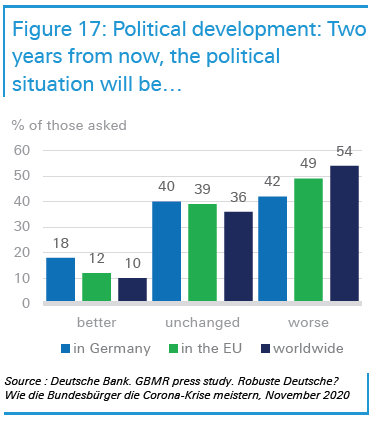 |
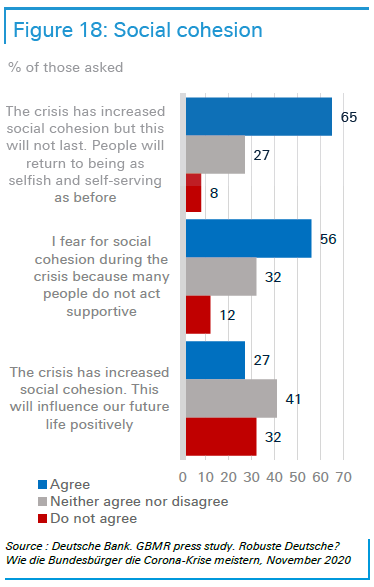 |
How to nudge people towards healthier behavior
The insights from behavioral economics have of course found their way into policymaking. In many countries governments employ special task forces or rely on scientific advisors from this field. Advice with regard to the COVID-19 pandemic has been summarized in several papers.21, 22, 23 However, while relevant, these recommendations sometimes come across as simplistic and obvious. While they might help those who are willing and cooperative they probably do not change the minds of dyed-in-the-wool “corona deniers”, i.e. people in fundamental opposition to the government’s response, questioning the severity of the pandemic or even the existence of the virus at all.
Some of the recommendations are:
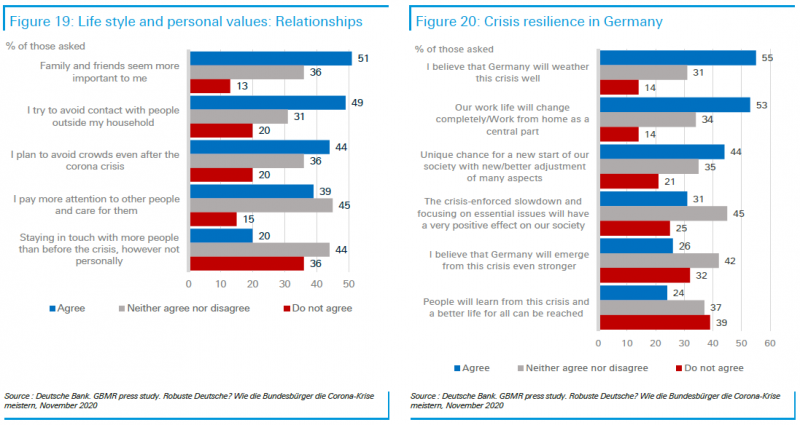
Government communication: A knife-edge exercise
The last point highlights what a fine line the government has to walk in its communication policy. At the end of April, the German Federal Ministry of the Interior, together with experts, produced a strategy paper, initially leaked and later published, which presented a set of drastic scenarios and explicitly recommended to aim for a maximum shock effect in communication by playing to people’s primal fears (suffocating, kids feeling guilty for the death of a parent, etc.). Another approach was using the (somewhat obscure) formula: 2019 = 1919 + 1929 to drive home the message that the COVID-19 pandemic, which started in 2019, might result in a damage equivalent to the combined effect of the Spanish flu (1919) and Great Depression (1929).24 In its worst-case scenario the analysis projected one million fatalities, just in Germany. This communication strategy certainly backfired. Of course, the knowledge about the actual infectious potential, medication, or the mortality rate of COVID-19 was rather limited at the end of April. Therefore, a scenario analysis was certainly a prudent approach. But corona deniers and sceptics have perceived this strategy paper as “proof” that the government is trying to manipulate the general public by massively exaggerating the likely impact. They used the government’s alleged over-statement as an argument in their motivated reasoning to question each and every piece of information or recommendation provided by the government thereafter. The repetition of sober warnings provided by Chancellor Merkel or Health Minister Spahn, wear off in the public’s perception, which is increasingly frustrated by the duration of the pandemic and the restrictions imposed on them, although a clear majority still sees the restrictions as justified and necessary. More recently, the government has started to use humor in its communication, launching a video clip on social media channels in which an engineer aged about 70 explains in retrospect how he – as a 22-year-old student – lived through the corona winter 2020, by “being lazy as a raccoon” on his couch.25 Humor is a well-known tool to overcome stress by taking a different perspective on your current situation. However, the public response was ambivalent.
Irrespective of the daunting complexity, provide all the arguments and let the individuals make up their own mind
Still, social media and media in general play an important role in channeling the public debate. Mainstream media, public service TV and radio, in particular, should actively work against any bias alleged by the corona deniers, as this undermines their credibility, making it easy to dismiss their reporting. Sceptics should get air time, but not, as happens all too often, by interviewing only the most obscure or animated people from the sidelines of demonstrations, with the all-too-obvious intention of discrediting the protest altogether. There are more than enough people among the, admittedly, heterogeneous participants in such protests against the COVID policies, who would make for a more open debate when, for example, participating in talk shows. This might give – at least the more moderate – corona sceptics the impression that their concerns are taken seriously. Shutting them out of the public debate, for example, in talk shows, or ridiculing them is grist for the mills of the corona sceptics and deniers. Moreover, it pushes them into the talk shows of obscure private stations, where they can express their crude arguments among like-minded participants without challenge.
The same argument applies to the debate in the German parliament, where the traditional parties should avoid responding with moral outrage to provocations of the opposition, providing them with the platform they are looking for, but rather attack flawed and incoherent reasoning with fact-based and comprehensible arguments.
Although Germany’s performance during the second wave has certainly been less outstanding than during the first, in April/May,26 the country is still handling the pandemic better than most of its European peers. In the Deutsche Bank survey from mid-September, 2/3 of the respondents appreciated the comprehensive economic support provided by the government. Less than 10% explicitly disapproved of the measures. Some 58% thought that the first lockdown made sense as it protected people’s health. On the other hand, 18% criticized the first lockdown as too large an infringement of their personal freedom. When individuals deliberate these obvious trade-offs, their assessment is heavily influenced by the perception biases discussed above. This should be accepted, given the human evolutionary success can be traced to fact that we became “social animals” with these biases often enhancing a smooth cooperation. Now it is for society, and its institutions, to make sure that they do not cause people to turn against society.
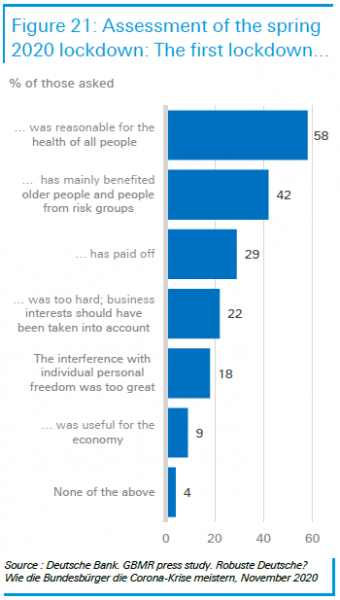
First published by Deutsche Bank Research; © Copyright 2020 Deutsche Bank AG, Deutsche Bank Research, 60262 Frankfurt am Main, Germany. All rights reserved.
Servus Nachrichten. Servus TV. October 16, 2020.
In Schleswig-Holstein gilt Beherbergungsverbot weiter. FAZ.net. 15.10.2020.
Kahneman, Daniel (2011). Thinking, fast and slow.
S. Sloman and P. Fernbach (2017). The Knowledge Illusion – Why We Never Think Alone.
Cass R. Sunstein (2020). How to Nudge Coronavirus Nonbelievers. Bloomberg Opinion. July 03.
P. Slovic (2010). The Psychology of Risk.
Gallup Panel, April 10-12, 2020.
KfW/ZEW Gründungspanel 2013.
https://www.economist.com/leaders/2020/10/10/the-real-lessons-from-swedens-approach-to-covid-19
Swedes question COVIVD-19 approach as second wave hits. Financial Times. 27.11.2020.
P. Slovic, ibid.
https://www.nationalreview.com/corner/deadly-covid-discrimination-against-the-elderly-in-sweden/
Hertwig, Ralph and Ido Erev (2009), The description-experience gap in risky choice. Trends Cogn. Sci.
Ibid.
Lührmann, M., M. Serra-Garcia and J. Winter (2013). Measuring Teenagers‘ Time Preferences Using Convex Budgets. CESifo.
van den Bos, W. and Ralph Hertwig (2017). Adolescents display distinctive tolerance to ambiguity and to uncertainty during risky decision making. Scientific Reports. January.
https://phys.org/news/2020-06-nudging-coronavirus-behavioral-economics.html
https://www.bundesregierung.de/breg-de/mediathek/videos/-besonderehelden-1817240
Deutsche Bank Research (2020), COVID-19: Crisis Resilience made in Germany.